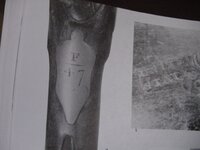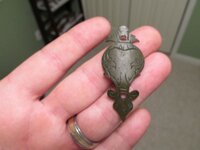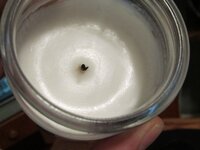Bartman
Sr. Member
mid 1800's site
Found this piece along with some other relics. It was about 8" down. It is heavy, but not made out of lead. The back piece looks like it connects to something.


Found this piece along with some other relics. It was about 8" down. It is heavy, but not made out of lead. The back piece looks like it connects to something.





![MVC-007F[1].jpg](/data/attachments/545/545711-e13342d480b9cbceed6eb37d0ec637b5.jpg)
![MVC-007F[1].jpg](/data/attachments/545/545717-e13342d480b9cbceed6eb37d0ec637b5.jpg)


 ).Once cool enough to touch I use qtips and cool peroxide & continue to wipe until the qtips quit looking dirty, never useing water unless in the beging before the boil to get the large easy stuff off.After that my wife likes burning sented candles all the time so I put them to the use.Mainly useing the white wax ones myself.What I do is take a qtip and wipe up the sweat from the wax on top.It looks like little beads of water but is wax oil.I then smear it with the qtip all over the sufface once covered I use dry ones & wipe up the extra until I'm happy.
).Once cool enough to touch I use qtips and cool peroxide & continue to wipe until the qtips quit looking dirty, never useing water unless in the beging before the boil to get the large easy stuff off.After that my wife likes burning sented candles all the time so I put them to the use.Mainly useing the white wax ones myself.What I do is take a qtip and wipe up the sweat from the wax on top.It looks like little beads of water but is wax oil.I then smear it with the qtip all over the sufface once covered I use dry ones & wipe up the extra until I'm happy.

![page-3[1].jpg](/data/attachments/586/586625-7041240f1241e6cbb6762891434e5672.jpg)
